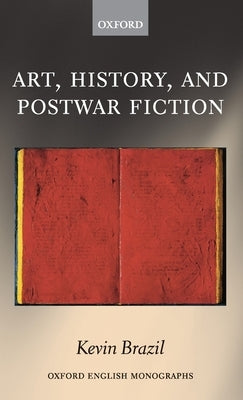1
/
of
1
Oxford University Press, USA
Art, History, and Postwar Fiction
Art, History, and Postwar Fiction
Regular price
$87.00 USD
Regular price
Sale price
$87.00 USD
Shipping calculated at checkout.
Quantity
Couldn't load pickup availability
Art, History, and Postwar Fiction explores the ways in which novelists responded to the visual arts from the aftermath of the Second World War to the present day. If art had long served as a foil to enable novelists to reflect on their craft, this book argues that in the postwar period,
novelists turned to the visual arts to develop new ways of conceptualizing the relationship between literature and history. The sense that the novel was becalmed in the end of history was pervasive in the postwar decades. In seeming to bring modernism to a climax whilst repeating its foundational
gestures, visual art also raised questions about the relationship between continuity and change in the development of art. In chapters on Samuel Beckett, William Gaddis, John Berger, and W. G. Sebald, and shorter discussions of writers like Doris Lessing, Kathy Acker, and Teju Cole, this book shows that writing about art was often a means of commenting on historical developments of the period: the Cold War, the New
Left, the legacy of the Holocaust. Furthermore, it argues that forms of postwar visual art, from abstraction to the readymade, offered novelists ways of thinking about the relationship between form and history that went beyond models of reflection or determination. By doing so, this book also argues
that attention to interactions between literature and art can provide critics with new ways to think about the relationship between literature and history beyond reductive oppositions between formalism and historicism, autonomy and context.
Author: Kevin Brazil
Publisher: Oxford University Press, USA
Published: 01/01/2019
Pages: 208
Binding Type: Hardcover
Weight: 0.85lbs
Size: 8.60h x 5.60w x 0.90d
ISBN: 9780198824459
ournal for Modern Literature.
novelists turned to the visual arts to develop new ways of conceptualizing the relationship between literature and history. The sense that the novel was becalmed in the end of history was pervasive in the postwar decades. In seeming to bring modernism to a climax whilst repeating its foundational
gestures, visual art also raised questions about the relationship between continuity and change in the development of art. In chapters on Samuel Beckett, William Gaddis, John Berger, and W. G. Sebald, and shorter discussions of writers like Doris Lessing, Kathy Acker, and Teju Cole, this book shows that writing about art was often a means of commenting on historical developments of the period: the Cold War, the New
Left, the legacy of the Holocaust. Furthermore, it argues that forms of postwar visual art, from abstraction to the readymade, offered novelists ways of thinking about the relationship between form and history that went beyond models of reflection or determination. By doing so, this book also argues
that attention to interactions between literature and art can provide critics with new ways to think about the relationship between literature and history beyond reductive oppositions between formalism and historicism, autonomy and context.
Author: Kevin Brazil
Publisher: Oxford University Press, USA
Published: 01/01/2019
Pages: 208
Binding Type: Hardcover
Weight: 0.85lbs
Size: 8.60h x 5.60w x 0.90d
ISBN: 9780198824459
About the Author
Kevin Brazil, Lecturer in Twentieth and Twenty-First Century Literature, University of Southampton
ournal for Modern Literature.
Share


